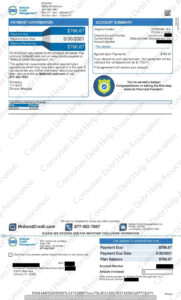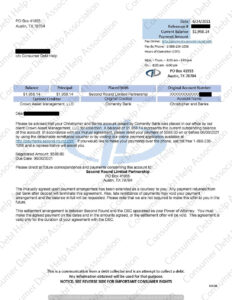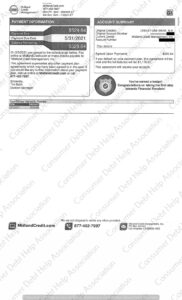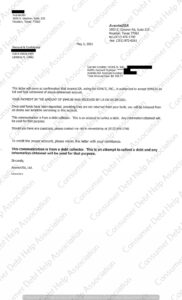Consumer Debt Help Association, Debt Relief Specialist wants to share a settlement letter from Citibank. Bal. $1703.71 Offer $766.67 Savings $937.04

Consumer Debt Help Association, Debt Relief Specialist wants to share a settlement letter from Citibank. Bal. $1703.71 Offer $766.67 Savings $937.04

Consumer Debt Help Association, Debt Relief Specialist wants to share a settlement letter from Christopher & Bank’s/Comenity Bank. Bal. $1958.14 Offer $588.00 Savings $1370.14

Consumer Debt Help Association, Debt Relief Specialist wants to share a settlement letter from Home Depot/Citibank. Bal. $7842.59 Offer $2745.00 Savings $5097.59

Consumer Debt Help Association, Debt Relief Specialist wants to share a settlement letter from Wells Fargo. Bal. $3600.46 Offer $1440.18 Savings $2160.28

Ways to Build Wealth at Any Age
Whether you want a worry-free retirement or a custom-built home, your financial goals are worthy investments. But they won’t come without careful planning.
When it comes to people’s top financial goals for 2021, Country Financial’s 2020 security index report found that controlling spending, saving for an emergency, paying down credit card debt or student loan debt, and saving for retirement were among top goals. Purchase-oriented goals—such as buying a car and purchasing a home—also made the list.
There are some tried and true ways to save money and build wealth at any age—whether you use those funds for immediate purchases, long-term goals such as retirement, or estate planning for after you’re gone.
The key is to start now, rather than wait until “the right time.” Here are some simple actions you can take today to get started building wealth and cash flow for tomorrow.
Set Short- and Long-Term Goals
The first step in building wealth is to set short and long-term goals you can revisit throughout your journey.
Short-term goals focus on achieving more immediate results, such as funding next summer’s trip or buying a new car. In contrast, long-term goals might require several years or more of preparation. For example, you may want to collect enough to pay off your mortgage or send your kid to college. Creating realistic goals at the start gives you direction, so make them as specific as possible.
Create a Budget
Once you know your goals, drafting a monthly budget becomes more manageable. Document up to three months’ worth of expenses and then break the list down into fixed costs, variable costs, necessary costs and discretionary costs. You can’t stop paying your utilities, but you will likely find places to save in your discretionary category (think restaurant meals, or entertainment expenses). Dedicate a portion of that discretionary spending to your goal’s fund regularly.
Taking stock of your financial situation gives you a clearer understanding of where you are, where you’re going to go, and how you’re going to get there.
Pay Off Deb
To dedicate more money toward building wealth and saving for your goals, you’ll likely need to pay off some debt first. You can use your discretionary income as a tool for minimizing your debt load. If you have multiple debts, consider using a debt repayment method, such as the avalanche method, the snowball method, reaching out to a debt settlement or debt consolidation company to accelerate the process.
Debt Repayment: The Avalanche Method
The avalanche method prioritizes high-interest debts by ranking the interest rates from greatest to least. Then, regularly pay the minimum on each of your debts, and put any leftover funds towards the one with the highest interest rate. Once you pay that off, continue on to the second-highest debt. Follow that pattern to minimize the interest you’re paying as you become debt-free.
Debt Repayment: Snowball Method
Alternatively, the snowball method is another debt repayment strategy. It’s essentially the opposite of the avalanche approach. List your debts from smallest principal to largest, ignoring the interest rates. Then, regularly dedicate enough funds to each to avoid penalties, and put any extra money toward the smallest debt.
After the smallest debt is paid, redirect your attention to the next largest debt, and so on. As the number of individual debts shrink, you’ll have more money to apply towards the larger debts. You may still have interests to worry about but picking off the debts one by one can impart a sense of forward movement and accomplishment.
Debt Settlement
With the Debt settlement method your credit will be affected because in order to settle debt the account need to be delinquent. This method is not right for everyone but if you are facing a mounting load of unmanageable amount of debt Debt Settlement may be the right option.
Debt Consolidation
Debt Consolidation is a method where a company will take all of your accounts under one umbrella, close them all, and pay them off with a reduced interest rate over a period of 5 years or so. This method is typically much more expensive than a debt settlement program.
Begin Investing
If you haven’t already, find out what if any employer-sponsored retirement savings plans are available to you, such as a 401(k). These qualified retirement plans offer tax advantages and typically allow you to direct a portion of your paycheck to your account, putting your savings on autopilot. If your workplace does not offer any retirement accounts, consider opening an IRA or a brokerage account to build an investment portfolio.
Generally, investing for retirement when you’re young means you can take on more risks. While a diversified portfolio is a standard strategy, younger investors might have a portfolio that’s heavier on equities early, since they may help you capitalize on long-term growth. As you get older and closer to retirement, your risk profile may change and your portfolio will need a rebalancing to incorporate more fixed-income investments.
How to Increase Your Income and Save More
You might be getting by on your current income, but if you had the chance to boost it, wouldn’t you? With an extra-positive cash flow, you could tackle debt, save more, and achieve your goals sooner. Here are a few ways to make that happen.
Ask for a Raise
Asking for a salary increase is one solution for improving your cash flow. All it takes is one good conversation, a positive work record—and a bit of courage and confidence. Speak to your peers and read up on how to conduct yourself when asking. Going in with a plan will save you anxiety and help you get your points across clearly.
Seek Other Investment Opportunities
When investment opportunities pop up, take advantage of the ones that speak to you whenever possible. Some may be easier to break into, like real estate, one of the world’s largest asset classes. Other reliable options include gold and silver, which you can invest in physically or through ETFs. For investors willing to take on a higher-risk opportunity, investing in startups may be appealing. It all comes down to what investment will best serve your personal short- and long-term goals.
Start a Side Gig
Additional work is also great to bulk up your resume and create new connections. It seems like everyone is starting up a side hustle these days. From online shops to freelancing, the opportunities are endless. All you have to do is determine your marketable skills and how to advertise them. There might be local opportunities, or you can create a profile online with related websites like Etsy or Hourly Nerd.
Cut Expenses
Sometimes it’s not about finding new currents of money, but about creating a larger pool with the money already coming in. Take a second pass at your list of discretionary expenses to pinpoint a few more areas you could cut back on without feeling the impact in your day-to-day life.
One good example: Automatically renewed subscriptions for streaming services and local businesses, like gyms, are convenient. But think about how frequently you use the service. If the answer is “not often,” you’re not getting your money’s worth—and you may want to negotiate a lower fee, or cut the subscription altogether.
How to Build Wealth at Every Stage of Life
While it’s good to have a general strategy in place for building wealth and increasing cash flow, different stages in your life may require you to focus on different things. Taking advantage of the opportunities each decade brings you will help you financially adjust and build a stable lifestyle.
In Your 20s
You may be right out of school and trying to navigate the job market, but don’t wait to start working towards your long-term financial goals. Future You will only be prepared if Current You starts planning now.
Create an Emergency Fund
Generally, an emergency fund should include about three to six months’ worth of living expenses. Although that sounds like a lot, you’ll be grateful for the cushion if you should lose your job, or crash your car, or have a medical emergency. Unexpected things happen all the time, and an emergency fund will protect you while you get things back up and running. It will also keep you from having to touch other savings accounts, like a retirement account.
Eliminate High-Interest Debt
Your student loans aren’t going anywhere, so pay them off as soon as possible. The same goes for any other high-interest debt you might have incurred, such as with a credit card. Paying off growing interest rates will bog down your ability to save.
However, don’t be afraid to use your credit cards. Your 20s are the perfect time to build credit, which will be vital to certain goals, like purchasing a house. Use them strategically and pay them off immediately to build an upstanding credit history.
In Your 30s
Your 30s may bring some stability into your life, whether it’s regular work, a partner, and/or kids. However, the costs you’re facing are likely growing with you. Focus on money moves that will benefit you long-term.
Plan for College Expenses
If you have children, saving for their education is a big step. Use opportunities like a 529 account to help provide the funding. A 529 plan is a tax-advantaged savings plan you can use to pay for future tuition and related costs. That said, many people who’ve been there, and done that, may advise against prioritizing your kids’ education over your retirement.
Pad the Nest Egg
By some popular estimates, by age 30 you should have at least one year’s worth of your annual salary saved for your retirement—and twice that by 35. Incrementally increasing the amount you put towards your savings will help boost that number as well.
In Your 40s and Beyond
By 40, conventional wisdom holds that you should be well on your way to a growing nest egg with three times your annual salary saved up. At this stage, you may also have other assets to your name, such as property. If you have kids, they might be nearing college age, and retirement might not seem quite as far away as it once did.
Protect Your Wealth
It’s always smart to protect your assets and yourself. Make sure you have insurance covering both your estate and yourself (through health and life insurance). Insurance can take a burden off of your family’s shoulders in case anything happens to you.
Capitalize on Make-Up Contributions
A make-up, or catch-up, contribution, is an additional payment that anyone over age 50 can make to their 401(k) or IRAs retirement savings account. If you’re in a financial position to contribute these extra funds, it can help bulk up those savings to help prepare for retirement.
For 2021, the maximum allowable catch-up contribution to 401(k) plans is $6,500. The IRA annual contribution limit for 2021 is $6,000, with those 50 and above allowed to contribute another $1,000 a year. Total, anyone over 50 can put $7,000 into their IRA annually.
Wait to Take Social Security
Did you know you could receive a higher Social Security benefit if you wait to claim your benefits? Those who hold off collecting Social Security until age 67 get 108% of their benefits, and those who wait until the age of 70 can receive 132% of their monthly benefit. On the other hand, if you begin taking benefits early, at age 62, you’ll receive 25% less in monthly benefits.
Shift Your Asset Allocation
Investors should periodically revisit their portfolio and reassess their investments and risk level. As you get closer to retirement, you may decide to allocate a larger part of your portfolio to safer choices like bonds and other fixed-income.
The Takeaway
Building wealth at any age starts with a frank look at your current income and expenditures, a detailed list of short-term and long-range goals—and a little follow-through based on where you are in life.
It’s never too late to start building your wealth. SoFi Invest® can help put you on the right path to begin saving for your future. With no SoFi management fees, you can focus on building the portfolio fit to your investment style. Whether you prefer being an active investor or would rather automate the process, there’s an option for you.
Consumer Debt Help Association, Debt Relief Specialist wants to share a settlement letter from Navy Federal Credit Union. Bal. $3995.32 Offer $1200.00 Savings $2795.32

Consumer Debt Help Association, Debt Relief Specialist wants to share a settlement letter from Credit One. Bal. $1176.97 Offer $2529.64 Savings $647.33

Consumer Debt Help Association, Debt Relief Specialist wants to share a settlement letter from Macy’s/Citibank. Bal. $796.35 Offer $279.00 Savings $517.35

As anyone who has ever watched their bank account balance decline after paying bills knows, owing money is no fun. But debt often serves an important function in people’s lives, putting things that can cost tens of thousands of dollars or more—a college degree, a starter home—within reach.
Such cases aren’t quite the same as racking up a high credit card balance on restaurant meals and shopping trips, underscoring that when it comes to owing money, there can be good debt and bad debt.
What Is Debt Exactly?
It’s a simple four-letter word, yet debt is often not as straightforward as it may appear. Carrying a credit card balance? That’s debt. Have a student loan or car lease? Also debt.
When individuals owe money, they generally have to pay back more than the amount they borrowed. Most debt is subject to interest, the borrowing cost that is applied based on a percentage of money owed.
Interest accrues over time, so the longer consumers take to pay off their debt, the more it may cost them.
Across people and households, debts add up. According to the Federal Reserve Bank of New York, by the end of 2020, total household debt climbed to $14.56 trillion.
Housing debt—specifically mortgages and mortgage refinancing—accounted for the majority of money owed, more than $10 trillion. Nonhousing debt such as credit card balances and school and car loans composed the rest.
For individuals in mid-2020, average debt amounted to $89,300, according to the credit reporting company Experian. While some types of debt were down—average credit card and home equity line of credit balances shrank by 14% and 7%, respectively, from the year before—other types, including amounts owed on personal loans, car loans, student loans, and mortgages, all increased from the year before, according to Experian.
Good Debt vs. Bad Debt
The difference between good debt and bad debt usually has to do with the long-term results of borrowing.
When you have debt, not only do you have to repay the money borrowed, but you also usually incur ongoing costs—specifically interest—which increase the amount you have to pay back.
While incurring more debt probably isn’t the most attractive proposition, there are occasions when taking on debt can be necessary or even beneficial in the long term. This is where good debt vs. bad debt comes in.
Though the idea of good vs. bad debt might seem complicated (and is often subject to some misconceptions), as a rule of thumb, the difference between good debt and bad debt usually has to do with the long-term results of borrowing.
Good debt is seen as money owed on expenditures that can build an individual’s finances over time, such as taking out a loan for school in order to increase one’s earning potential, or a mortgage on a house that is expected to appreciate in value.
Bad debt is money owed for expenses that pose no long-term value to a person’s financial standing, or that may even decrease in value by the time the loan is paid off. This can include credit card debt and car loans.
While owing money may not feel great, debt can serve some helpful functions. For starters, your credit score is used by lenders to determine eligibility and risk level when it comes to borrowing money.
Your credit score is based on your history of taking on and paying off debt, and helps to inform a lender about how risky a loan may be to issue. Your credit score can play an important role in determining not only whether a credit card or loan application will be approved but also how much interest will be charged.
With no credit history at all, it may be harder for a lender to assess a loan application. Meanwhile, a solid track record of paying off good debt on time can help inspire confidence.
While there are no guarantees, good debt can also mean short-term pain for long-term gain. That’s because if paid back responsibly, good debt can be an investment in one’s future financial well-being, with the results ultimately outweighing the cost of borrowing.
Conversely, with bad debt, the costs of borrowing add up and may surpass the value of a loan.
What is Considered Good Debt?
Mortgages
Like other lending products, mortgages are subject to annual interest on the principal amount owed.
In the United States, the average rate of a 30-year fixed-rate mortgage has seen a prolonged period of lows, averaging 2.97% nationally in February 2021, according to the Federal Reserve Bank of St. Louis.
Meanwhile, data from the Federal Housing Finance Agency showed that home prices grew 10.8% from the end of 2019 to the fourth quarter of 2020, marking a steady increase since late 2011.
This illustrates how the potential appreciation of a home might outweigh the cost of financing. But it’d be best to not assume that taking on a mortgage to buy a house will increase wealth. Things like neighborhood decline, periods of financial uncertainty, and the individual condition of a home could reduce the value of a given property.
Personal or home equity loans used to improve the condition of a home may also increase its value, and in such instances may also be considered “good” debt.
Student Loans
Forty-three percent of Americans who attended college incurred some kind of education debt, according to the Federal Reserve, with most outstanding loans in a recent year coming in between $20,000 and $25,000. This translates to average monthly payments between $200 and $300.
Cumulative income gains may eclipse the cost of a student loan over time.
But higher education can be linked with greater earnings, and cumulative income gains may eclipse the cost of a student loan over time.
An analysis by Northeastern University found that the median weekly earnings for a bachelor’s degree holder, $1,248, are more than $500 greater than the median weekly pay of someone with a high school diploma only.
Comparing earnings of someone with an associate degree to a bachelor’s degree holder equates to a stark difference—more than $750,000 over the course of 40 years, the analysis found.
But just as taking out a mortgage is not a sure-fire way to boost net worth, student debt is not always guaranteed to result in greater earnings. The type of degree earned and area of focus, unemployment rates, and other factors will also influence an individual’s earnings.
What is Considered Bad Debt?
Credit Card Debt
Credit cards can be useful financial tools, helping people track expenses and align payments with their individual pay periods. They may even provide cash back or other rewards. And because interest is generally not charged on purchases until the statement becomes due, using a credit card to pay for everyday purchases needs not be costly.
However, credit cards are often subject to high interest rates. According to the Federal Reserve, the average annual interest rate for credit cards is 14.65%—but some charge 20% or higher.
This interest adds up, making that takeout dinner or pair of jeans far more costly than the amount shown on its price tag, if a balance is carried over. For example, if you were to charge $500 in takeout food to a credit card with a 20% APR but only pay the $10 minimum each month, it would take nine years to pay off the full balance. The total amount paid—including interest—would be $1,084. That’s more than double the cost of those takeout meals!
Cars famously start to lose value the second you drive them off the lot.
A new vehicle loses 20% of its value in the first year of ownership, according to Carfax. After five years, a car purchased for $40,000 will be worth $16,000, a decrease in value of 60%.
But a car may also be necessary for getting around. For some individuals, owning a car can also help to earn or boost income, reducing or negating depreciation.
The Takeaway
Both good debt and bad debt can be stressful—and both types of debt can be more costly than they need to be if you don’t stay on top of what you owe and pay back loans efficiently. A digital tracker could be the remedy.
Consumer Debt Help Association, Debt Relief Specialist wants to share a settlement letter from Kohl’s/Capital One. Bal. $2106.77 Offer $948.06 Savings $1158.71

copyright 2025 Consumer Debt Help Association - 516 N. Dixie Highway, Lantana, FL 33462. All Rights Reserved